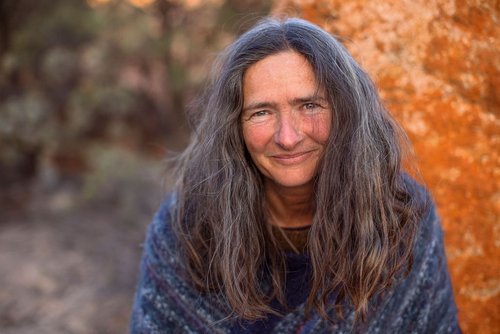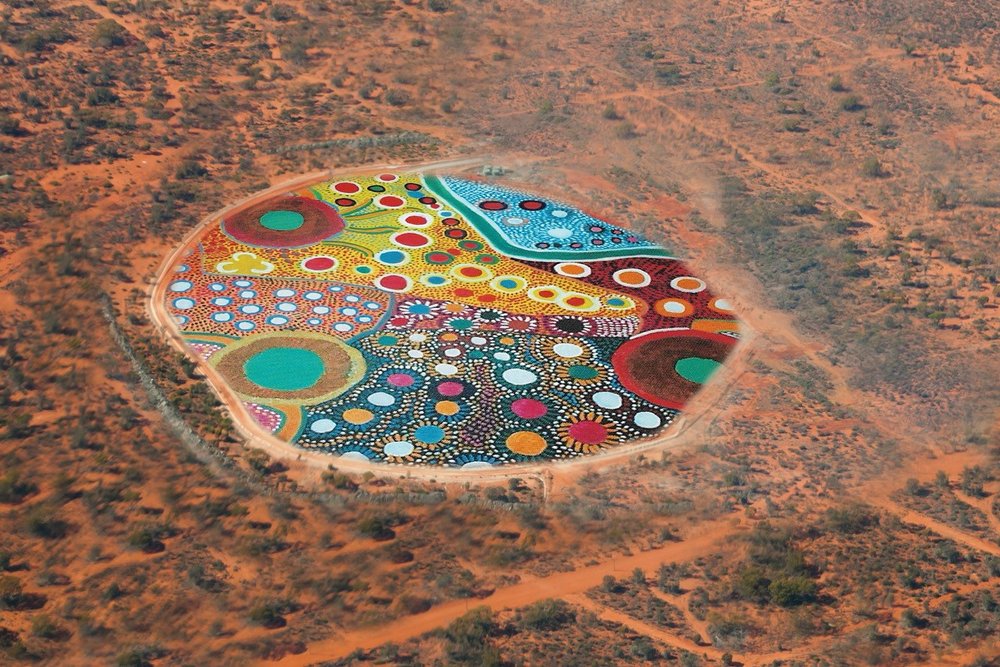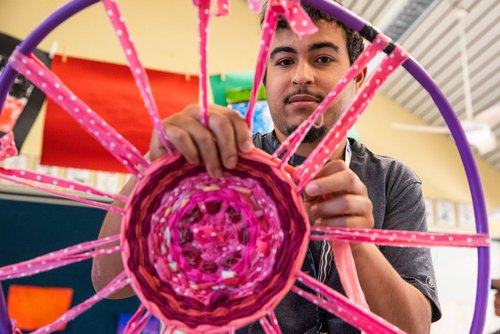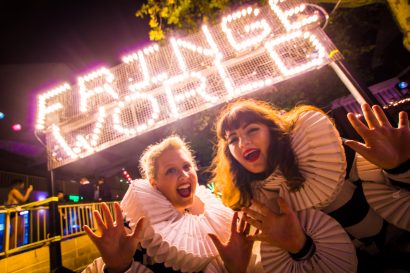The winners of the inaugural Arts Impact WA grant will be announced on 24 May 2022. Rosalind Appleby catches up with one of the finalists, Vivienne Robertson, who is calling us to weave our country whole.
An art project that will weave our country whole
19 May 2022
- Reading time • 10 minutesVisual Art
More like this
- A walk with Tina Stefanou
- A blaze of glorious people
- Diving into the gothic world of Erin Coates
In Australia we’ve dug 50,000 holes across sacred land. We dump 500,000 tonnes of fabric and clothing every year. Can we give our hands and hearts in healing to create 5,000 rugs to seal one hole?
This is the question asked by Vivienne Robertson and the team behind Reclaim the Void, a project which is one of six finalists in the Arts Impact WA Awards. The cross-cultural project was born from Ngalia elders in Leonora, Western Australia, expressing their grief at ‘those gaping mining holes left all over our country’. Rosalind Appleby talks with director Vivienne Robertson about how the idea was conceived to symbolically ‘seal’ one of the holes with an artwork expressing the story of country.

Rosalind Appleby: Vivienne you are a conceptual artist and creative director, from the south coast of WA and you’ve been delivering large-scale art projects and festivals for the past 20 years. What is it about site-specific art like Reclaim the Void that appeals to you?
Vivienne Robertson: I was introduced to site specific art by the French artist Francois Davin. He founded the Artists in Nature International Network. I invited Francois to create and deliver a five day training on site specific art, where he outlined his principles of art as an encounter between artist, site and community; and how this can include the stories, imaginative aspects, topography, potential and functionality of a site and the community who care for it. Communities can be empowered to drive or ‘own’ the creation of art on the land for which they care, enhancing their own appreciation, understanding and relationship with where they live. I feel this is very alive and potent – especially in our current times, where we’re craving connection with our natural selves, and with nature around us. It resituates art as a natural part of our relationships, and as a vehicle for the more subtle truths. Site specific art allows us to create art from inspiration beyond the realm of individual ego, and this seems to be such a welcome relief to us all!
RA: Reclaim the Void launched in 2021 as a collaboration between you and Kado Muir from the Ngalia Heritage Research Council. Tell us how the vision came about?
VR: The vision for Reclaim the Void came from a visit to Leonora in 2013. I’d invited the British land artist Chris Drury to WA and took him up to Leonora to discuss a possible art project related to Maralinga and the proposed Yeelirie uranium mine. The elders were interested, but I felt there was something else. So I asked this question: “What is your deepest pain?” Sometimes it’s about asking the right question, and I feel this was one of those times. One of the aunties said “It’s all those gaping mining holes left all over our country”, and the others nodded and said “Yes”. Probably because I’m a wadjella and want to fix things, I just saw, and said, “How about we seal one of those holes with something that has the pattern of your story of country on it?”There was a pause, filled with gravitas, and aunty nodded, looking straight at me, and said “Yes, do that”. Kado and Deeva Muir were at that meeting, and we touched base on the idea from time to time, and then seven years later, at two song/dance/culture retreats Kado and I were co-leading, he said it was right timing for the project to begin. He came up with the title and at the second retreat, artist Lucy Ridsdale arrived with her handmade rag-rug, and Kado immediately saw that this was what we’d use, combining rugs into dots to make a giant dot artwork.
RA: You’re currently in the middle of a ‘rug camp’, on country. What exactly is a rug camp?
VR: I’m writing this from the middle of a rug-making sacred retreat, where 18 people are sitting under the full moon weaving rugs and chatting and laughing, after having come back from a cultural walk with Kado along the ridge and through caves. The camps, or retreats, on country area so important to this project. They offer people the chance to really immerse in, and learn about, country, whilst making rugs. It grounds the making culturally and spiritually. We’re creating new community, and webs of communities. People have returned from prior camps and become passionate about the project, and are now leading rug hubs and offering schools and community workshops.
RA: I love the idea of upcycling old clothes into rugs, but how will 5000 of these rugs be turned into a massive carpet large enough to cover an open cut mine site?
VR: The project has its own life. It has unfolded very organically, and we’ve stayed true to this, rather than adopting a more ‘rational’ approach, which can perhaps ensure outcomes, but can also kill the spirit of art. So we dived in before knowing exactly how the final work would be mounted. Since then, however, we’ve consulted engineers, and there are four different installation possibilities. Suspended over an open pit is the most complex – our preferred option is a back-filled pit, which involves less anchor points and infrastructure. We’re still seeking the site, but have two mining companies who we’re in discussion with. Both Kado and myself believe the perfect site will reveal itself before long – it’s how this project has unfolded so far.

RA: You also believe the project will bring healing to country, healing to community and healing to ourselves. How will this come about?
VR: believe healing occurs when we come closer to the truth of who we are as humans. I feel we’ve lost our way – forgotten who we are, and got caught with a false sense of the individual ‘I’. An ‘I’ who is not connected with the whole web of life. We long to belong – to place, to the interconnected matrix of the diversity of life, all of which shares the same sun, air, water, earth. For me, healing begins when we feel this connection, when we feel part of the whole, no more or less important than any other part. Making a rug offers us a chance to be part of, and contribute to the whole, and to make a creative act which is simple and modest, but also profound in its outcome. Country, community and individual are not separate.
In this moment of pause, we have an opportunity to reflect on where we’ve been, what sort of world we’ve created, and who we really are – or could be. Part of that is acknowledging the pain we’ve caused others – in this case, our First Nations sisters and brothers, and their beautiful home. If we can acknowledge that we have played a part in this, witness their pain, and then offer a gesture of sorrying – that is a part of the work of healing. It’s not the end – we need to make changes in how we live, but it’s a step amongst many other similar steps across the planet. The project was born from witnessing the grief of people for the scars left on their sacred land, and like you might with a dear friend in grief, you sit alongside them in that pain, and perhaps make something symbolic as a gesture to show them that you hear their grief, and are so sorry that is has been that way.
RA: Since launching in 2021 the story has gone global, with people around the world wanting to become involved in the event. Why do you think it is having such an impact?
VR: The responses we’ve had from around the world are all from people saying roughly the same thing: we care about what we’ve done to country, to the home of First Nations people, and we want to give our hearts and hands in a gesture of saying sorry. The project’s touched the depth of compassion which is natural in people’s hearts – and this doesn’t have borders. People around the world know about Australian Aboriginal people’s immense cultural and spiritual depth, and they also know that Australia has only recently begun to acknowledge and appreciate those depths, and to try to reconcile the immense damage done over the past couple of hundred years as part of its moving toward a different future.

In many ways the project – and the symbolic healing it asks – is a response to the over-consumption and the over-extraction of resources which is at the root of where we’ve come out of rhythm with ourselves and our planet. This is an international issue.
RA: Tell us about the rug hub happening in the US in New Hampshire?
VR: The Mariposa Museum and World Cultural Centre in New Hampshire, USA, contacted us to ask if they could become a rug hub during their showing of West Australian Noongar artist Shane Pickett’s exhibition. That exhibition is a collaboration between the Mossenson Art Foundation in Perth, the Australian Embassy in Washington, and the Kluge-Ruhe Aboriginal Art Collection at the University of Virginia. The exhibition will be displayed from June to October, and whilst it’s on, they will have the space set up for people to come and weave rugs for the project. It’s delightful!
RA: The project continues to gain momentum and was recently named one of six finalists for the inaugural $100 000 WA Arts Impact award (winners to be announced 24 May). You also have a partnership with the WA Museum for an exhibition in 2023. What can people in WA do who want to be involved?
VR: Yes, we’re really excited about the partnership with the WA Museum, and so thrilled to be announced as finalists with the Arts Impact WA award. They were calling for projects that were compelling, unique and ambitious, building a sense of community and with strong impact, so it was irresistible to put up our hands!
There are many ways people can be involved – it is a wonderful experience is to come out on country and weave in the presence of this ancient land, and its custodians. We also have a series of schools and community workshops planned, and many people are also contacting us asking if they can run their own workshops for the project. Rug hubs are springing up everywhere – where a person, group of people or organisation offer to hold the space for people to gather together to make rugs. This is also happening informally with groups of friends coming together to weave.
We’ll be updating the website with new rug hub workshops and opportunities to be involved. We’ve got some online resources so people can start weaving, and are in the process of developing a schools package. And for anyone who’s not a weaver, we are accepting donations, or there may be some other skill someone may have and wish to offer. Really its about gathering together, and making something for the whole, with a deep respect for country and its cultural and spiritual custodians. It’s a way of walking forwards together, so we invite anyone with this in their hearts to be part of the journey of Reclaim the Void.
Find out more about Reclaim the Void.
Pictured top: handwoven ragrugs will be used to make a brightly coloured artwork to cover an open pit mine. Photo: Nic Duncan
Like what you're reading? Support Seesaw.






